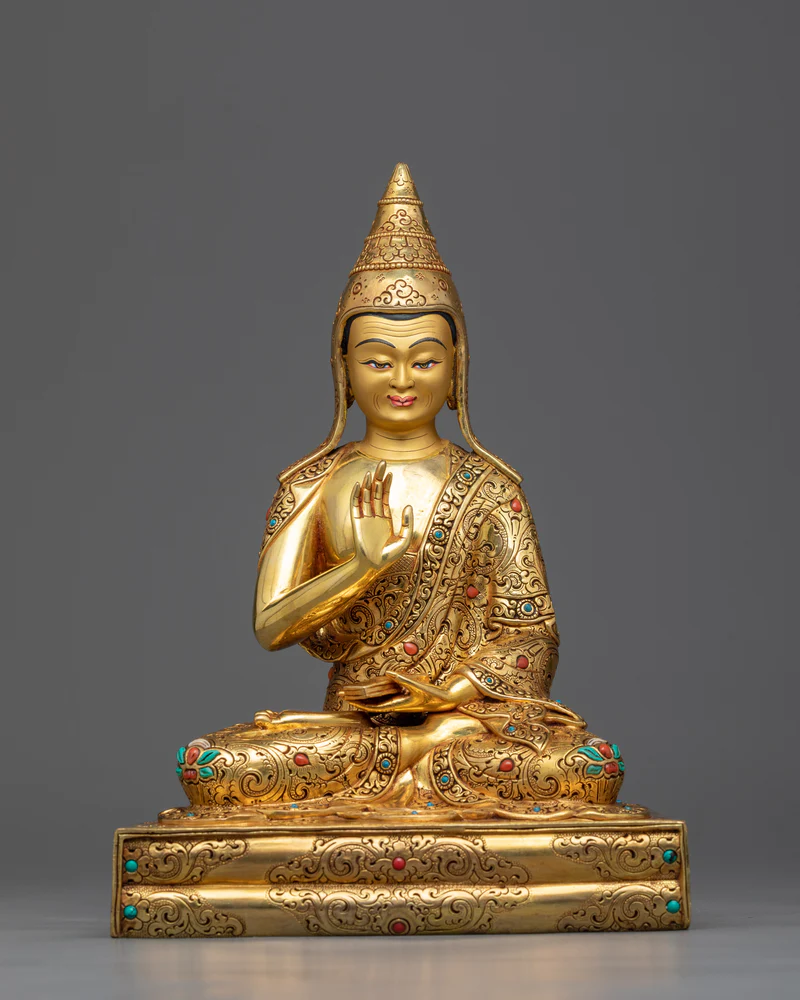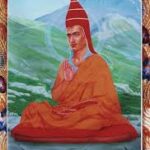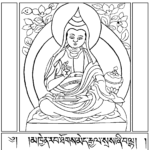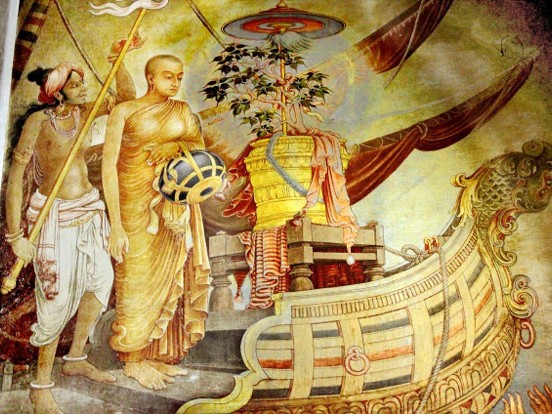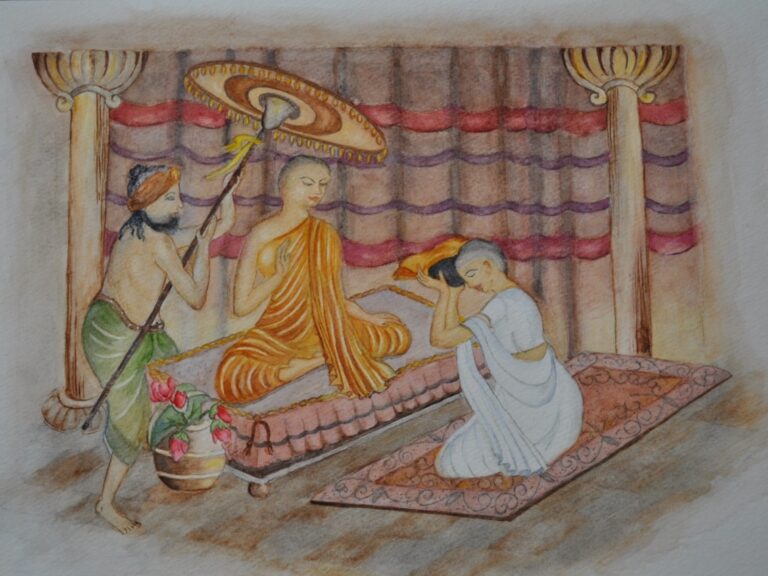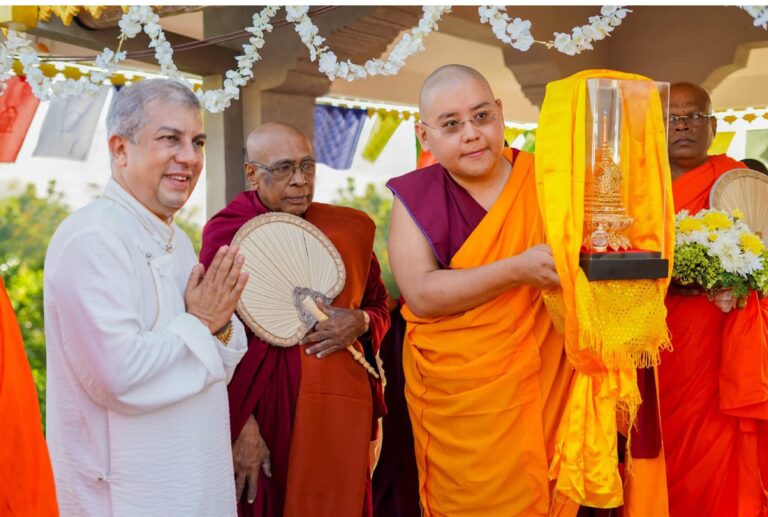From root of Seventeen Nalanda Masters: གདུལ་བྱའི་ཁམས་བཞིན་གཉིས་སྟོང་དབུ་མའི་ལམ། ། Founder of the tradition which skilfully combines Mādhyamika and Pramāṇa, སྲོལ་བཏོད་དབུ་ཚད་རིགས་ཚུལ་འབྱེད་མཁས་ཤིང༌། ། Teaching the Middle Way path of twofold emptiness according to the capacity of disciples, ཁ་བའི་ལྗོངས་སུ་རྒྱལ་བསྟན་སྤེལ་མཛད་པ། ། And introducing the Buddha’s teachings to the Land of Snows— མཁན་ཆེན་ཞི་བ་འཚོ་ལ་གསོལ་བ་འདེབས། ། Great Khenpo Śāntarakṣita, to you I pray! The founder of Yogachara …
From root of Seventeen Nalanda Masters:
གདུལ་བྱའི་ཁམས་བཞིན་གཉིས་སྟོང་དབུ་མའི་ལམ། །
Founder of the tradition which skilfully combines Mādhyamika and Pramāṇa,
སྲོལ་བཏོད་དབུ་ཚད་རིགས་ཚུལ་འབྱེད་མཁས་ཤིང༌། །
Teaching the Middle Way path of twofold emptiness according to the capacity of disciples,
ཁ་བའི་ལྗོངས་སུ་རྒྱལ་བསྟན་སྤེལ་མཛད་པ། །
And introducing the Buddha’s teachings to the Land of Snows—
མཁན་ཆེན་ཞི་བ་འཚོ་ལ་གསོལ་བ་འདེབས། །
Great Khenpo Śāntarakṣita, to you I pray!
The founder of Yogachara Sutantrika Madhyamaka, the great abbot Śāntarakṣita, was the middle son of a king who ruled in the eighth century in the city of Bengal or Sahor in eastern India. He was the second son among his siblings, who included two brothers and sisters. His elder brother was called Dharmaraja, the middle one was Śāntaraksịta, and the youngest was Mandarawa, who later became the queen of the Great Pandit Padmasambhava.
From his youth, he understood that the householder’s life was akin to a dungeon, the source of much suffering and the root of all afflictions and wrongdoing. Without attachment to the joy and happiness of cyclic existence, he discarded his kingdom like spittle. He was ordained and received full ordination from the officiating abbot Jñānagarbha. Belonging to the Mulasarvāstivāda school among the four root schools, he comprehended all the prohibitions, affirmations, and permissions delineated in the four scriptural collections of the Vinaya of that Mulasarvāstivāda school. He maintained pure morality, free from even the slightest transgression of the precepts or naturally negative acts, diligently studied the Tripitaka (Three Baskets of Training), and excelled in learning.
He studied under Jagaddhara, then received esoteric instructions on the stages of the path. He relied on the master Vinayasena, received the Ornament of Clear Realization, and thoroughly mastered the entire meaning of his esoteric instructions, including the perfection of wisdom sutras.
He discovered that the stages of the Mahāyāna path encompass extensive and profound teachings, both of which are indispensable. He meticulously studied the Madhyamaka texts, which contain the ultimate pith instructions expounding Nāgārjuna’s Buddha thought. He thoroughly examined the meaning of these texts with flawless reasoning, gaining profound certainty and applying it to his mindstream, putting it into practice. He developed extraordinary experiential realization in the complete corpus of the Mahayana path stages and generously imparted the elixir of the Dharma to other fortunate beings. He composed the Ornament of the Middle Way and its commentary, and in India, he illuminated the instructions on the perfection of wisdom like the sun. This great being had many disciples. The two principal disciples or sons who were without rival were the master Haribhadra and the supreme scholar Kamalaśīla.
The great scholar Śāntarakṣita possessed the courage of a bodhisattva, which is difficult for other bodhisattvas to fathom, along with the profound power of bodhicitta. Therefore, in working for the welfare of beings in this degenerate age, his conduct was the most excellent among the heirs of the Bodhisattvas.
Tsongkhapa praised him as Vairocana Buddha, the treasure of vast conduct.
He served as both Abbot and master at Vikramasila. Later in life, he moved to Nalendra where he became Abbot. Because of his bodhichitta, he was referred to as a bodhisattva. In India, he was known as Shantarakshita, and in Tibet, he was called “Shewa Tso”. In his work, Compendium of Principles on Valid Cognition, the Sanskrit term “Pramana” is absent. Subsequently, Tibetan scholars and translators referred to it as “Pramana”. In the context of countering critics of this text, it often involves logical reasoning, hence the text is also known as the Compendium of Principles of Logic.
Śāntarakṣita’s Compendium of Valid Knowledge was written in the eighth century. In this treatise, he thoroughly analyzed the various subtle analyses and the development of philosophical systems in India from the time of the peerless sage, the Buddha, who lived before the eighth century, up to Nāgārjuna and through the end of the eighth century. He gathered all these intricate points into one comprehensive work.
Having examined this deeply with his supernormal cognition, the great abbot recalled his previous lives. He remembered his aspirations from those lives to propagate the teachings of Buddha Śākyamuni in the religious land of Tibet and to guide those who would be influenced by him. He felt compelled to go, even though no one from Tibet had invited him, so he initially went to Nepal. He stayed there for an extended period, where the king of Nepal became his patron, establishing a spiritual connection between the great abbot and the king.
Top of Form
Bottom of Form
Later, when the people who had invited him from Tibet arrived, Śāntarakṣita experienced special auspicious signs and indications. Thus, he embarked on his journey towards Tibet and began spreading the teachings. The great abbot bodhisattva and Master Padmasambhava conducted the ritual of the site, and following the instructions of Śāntarakṣita, the foundations of the Samye temple were laid in the year of the female fire-hare, modeled after the temple of Odantapuri.
In the female Earth Hare year, the construction was completed, and the great abbot and master performed the consecration and celebrations.
The temple was named Samye Tsuklakhang, which translates to “the temple of the three unchanging and spontaneously present systems.” These three systems encompass:
- Architectural Style: Reflecting influences from India, China, and Khotan.
- Construction Style: Considered to be in accordance with the Vinaya.
- Lineage: Following the Sutrayana tradition.
- Assembly of Deities: Adhering to the Vajrayana tradition.
After completing the temple, the great abbot Shantarakshita and Master Padmasambhava conducted the consecration and celebrations. In the Year of the Sheep, Shantarakshita invited twelve monks who held the Mulasarvastivada view from Vikramalasila monastery. Acting as the officiating abbot, Shantarakshita ordained seven men, including Yeshi Wangpo, as novices. Upon their ordination, they manifested inconceivable qualities such as clairvoyance and super-knowledge.
Shantarakshita was the first to establish the Sangha Community in Tibet, demonstrating immense kindness. He was the founder of the Svatantrika Madhyamaka school within the Yogacara tradition and played a crucial role in establishing a solid foundation for Buddhism in Tibet.
The Compendium of Principles of Valid Cognition, or the Great Exposition of Valid Cognition, is a philosophical system that was later translated into Tibetan. The translation occurred after the death of the Tibetan king Langdarma, during the reign of Lha Lama Yeshé Ö, the youngest son of Ngari Gugé king Tashi Gön. The translation was undertaken by the translator Rinchen Sangpo.
The commentary on the Compendium of Principles was particularly challenging to translate, accomplished with great effort by two translators, Drakjor and Sherab. Their tremendous efforts resulted in this being the first translation of its kind into Tibetan. Despite Tibetan scholars studying the text during this period, its teachings were not consistently propagated or widely disseminated.
Later, when the great Kashmiri pandit Śākyaśrī traveled to Tibet, the renowned Nālandā sites in India suffered destruction, marking an unfortunate era where the study of texts on valid cognition, Buddhist texts, and philosophical systems nearly faded away. Śākyaśrī Matilal, the last abbot of Vikramalashila monastery which was destroyed during that period, went to Tibet. Many other eminent pandits also accompanied him on this journey.
The first to arrive in the Snow Land (Tibet) were the Sakya masters, who settled there. Sakya Paṇchen became their disciple, marking the beginning of the widespread dissemination of the textual system in the Sakyapa area.
In particular, Śāntarakṣita made a significant and profound contribution to the spread of logic (Pramāṇa) and Madhyamaka, composing treatises such as the “Treasury of Reasoning” on logic (Pramāṇa). The opportunity to study and establish the Compendium of Principles of Valid Cognition in Tibetan arose in the land of snows around the eleventh century. From then on, it became the foundational text on knowledge for Tibetan schools, serving as a reliable Indian text across all schools.
In this treatise by the great abbot Śāntarakṣita, the “reality” refers to the objectionable nature, which is posited as the essence of existence or the primary topic established within any school of philosophical tenets.
The second aspect, known as “the summary of reality,” earns its name because it encapsulates all the subjects of the natural state established by all philosophical systems in one comprehensive framework.
Thus, this text not only stands as a valid philosophical treatise but also represents the Yogācāra Svātantrika Madhyamaka tradition. This tradition rejects the conventional acceptance of external objects and instead refutes the inherent existence of phenomena. It asserts that phenomena are ultimately established as the nature of mind-only.
The great abbot Śāntarakṣita, founder of the Yogācāra Svātantrika Madhyamaka, authored treatises that embody the essence of Yogācāra Svātantrika Madhyamaka texts. These texts form the basis of a view that refutes the inherent establishment of phenomena. They articulate doctrines asserting that phenomena are established by their own character, without affirming the conventional existence of external objects.
Before his death, the supreme abbot left his final testament to the Dharma king Trisong Detsen under the care of Ba Yeshe Wangpo. Subsequently, whenever issues arose concerning the integrity of Buddhism or faced criticism, he instructed his disciple Kamalashila to be invited to Tibet. In summary, the great abbot Śāntarakṣita dedicated himself to extensive Dharma activities for the benefit of the teachings and beings. He then passed away into Parinirvāṇa.
Get in Touch with Us
We’d love to hear from you—share your thoughts or ask a question!

